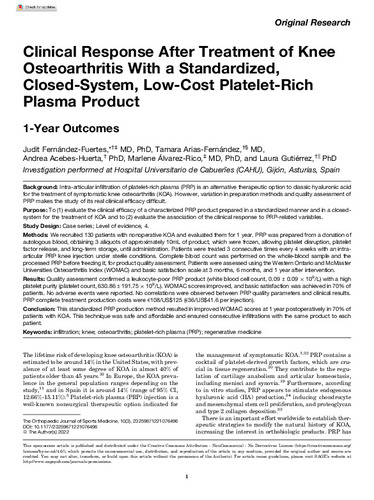Clinical Response After Treatment of Knee Osteoarthritis With a Standardized, Closed-System, Low-Cost Platelet-Rich Plasma Product: 1-Year Outcomes
Fecha de publicación:
Versión del editor:
Citación:
Resumen:
Background: Intra-articular infiltration of platelet-rich plasma (PRP) is an alternative therapeutic option to classic hyaluronic acid for the treatment of symptomatic knee osteoarthritis (KOA). However, variation in preparation methods and quality assessment of PRP makes the study of its real clinical efficacy difficult. Purpose: To (1) evaluate the clinical efficacy of a characterized PRP product prepared in a standardized manner and in a closed-system for the treatment of KOA and to (2) evaluate the association of the clinical response to PRP-related variables. Study design: Case series; Level of evidence, 4. Methods: We recruited 130 patients with nonoperative KOA and evaluated them for 1 year. PRP was prepared from a donation of autologous blood, obtaining 3 aliquots of approximately 10mL of product, which were frozen, allowing platelet disruption, platelet factor release, and long-term storage, until administration. Patients were treated 3 consecutive times every 4 weeks with an intra-articular PRP knee injection under sterile conditions. Complete blood count was performed on the whole-blood sample and the processed PRP before freezing it, for product quality assessment. Patients were assessed using the Western Ontario and McMaster Universities Osteoarthritis Index (WOMAC) and basic satisfaction scale at 3 months, 6 months, and 1 year after intervention. Results: Quality assessment confirmed a leukocyte-poor PRP product (white blood cell count, 0.09 ± 0.09 × 109/L) with a high platelet purity (platelet count, 630.86 ± 191.75 × 109/L). WOMAC scores improved, and basic satisfaction was achieved in 70% of patients. No adverse events were reported. No correlations were observed between PRP quality parameters and clinical results. PRP complete treatment production costs were €108/US$125 (€36/US$41.6 per injection). Conclusion: This standardized PRP production method resulted in improved WOMAC scores at 1 year postoperatively in 70% of patients with KOA. This technique was safe and affordable and ensured consecutive infiltrations with the same product to each patient.
Background: Intra-articular infiltration of platelet-rich plasma (PRP) is an alternative therapeutic option to classic hyaluronic acid for the treatment of symptomatic knee osteoarthritis (KOA). However, variation in preparation methods and quality assessment of PRP makes the study of its real clinical efficacy difficult. Purpose: To (1) evaluate the clinical efficacy of a characterized PRP product prepared in a standardized manner and in a closed-system for the treatment of KOA and to (2) evaluate the association of the clinical response to PRP-related variables. Study design: Case series; Level of evidence, 4. Methods: We recruited 130 patients with nonoperative KOA and evaluated them for 1 year. PRP was prepared from a donation of autologous blood, obtaining 3 aliquots of approximately 10mL of product, which were frozen, allowing platelet disruption, platelet factor release, and long-term storage, until administration. Patients were treated 3 consecutive times every 4 weeks with an intra-articular PRP knee injection under sterile conditions. Complete blood count was performed on the whole-blood sample and the processed PRP before freezing it, for product quality assessment. Patients were assessed using the Western Ontario and McMaster Universities Osteoarthritis Index (WOMAC) and basic satisfaction scale at 3 months, 6 months, and 1 year after intervention. Results: Quality assessment confirmed a leukocyte-poor PRP product (white blood cell count, 0.09 ± 0.09 × 109/L) with a high platelet purity (platelet count, 630.86 ± 191.75 × 109/L). WOMAC scores improved, and basic satisfaction was achieved in 70% of patients. No adverse events were reported. No correlations were observed between PRP quality parameters and clinical results. PRP complete treatment production costs were €108/US$125 (€36/US$41.6 per injection). Conclusion: This standardized PRP production method resulted in improved WOMAC scores at 1 year postoperatively in 70% of patients with KOA. This technique was safe and affordable and ensured consecutive infiltrations with the same product to each patient.
ISSN:
Patrocinado por:
This study was partially supported by an intramural 2018 postdoctoral grant and an intramural 2019 fomento proyectos grant (Fundación para la Investigación y la Innovación Biosanitaria de Asturias [FINBA]) to A.A.-H. and I+D 2017 and 2020 grants (SAF2017-85489-P and PID2020-117265GB-I00, respectively; Ministerio de Ciencia e Innovación, Spain and Fondos FEDER) to L.G.
Ficheros en el ítem





